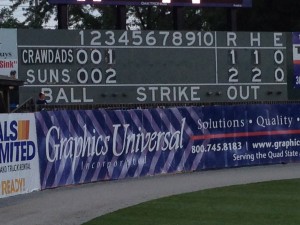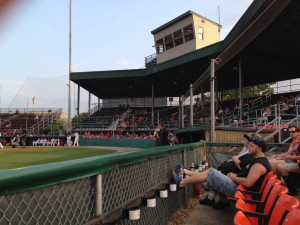The Mets lost to the Pirates in a quiet, unmemorable game that at least saw Terry Collins manage a bullpen the way one would like: he was cognizant of his starting pitcher’s gas tank and brought his closer in when it mattered instead of when baseball conventional wisdom (which is 90% mythical and the other half wrong anyway) told him to. It was a modest little game, but one that delivered a judgment that was both impartial and unsurprising: Don’t waste your own outs (David Wright, Ike Davis) and don’t give the other guy extra ones (Ike again).
Oh, and don’t walk guys with the bases loaded, because that’s bad.
The only bit of news, besides Ike being rather obviously still not fixed, is that Jordany Valdespin has finally been demoted after an eternity spent rotting on the bench, a Metsian habit of late with young players that I find, well, deplorable. Here’s predicting JV1 sees little or no time in Vegas — I bet the Mets trade him for some fringy prospect we never hear from again, Jordany kicks up a one-day WFAN ruckus on his way out, and then he continues becoming Victor Diaz somewhere else.
I want to tell you about Tuesday night’s game, though — no, not the Mets beating the Giants, though that was fun. I want to tell you about my night with the Hagerstown Suns and the Hickory Crawdads.
I just got back from a few days driving the backroads of Adams County, Pa., and Carroll and Frederick Cos., Md. — digging through file cabinets at historical societies and checking out old houses and former farms on both sides of “the Line.” My mother’s ancestors are from those counties — they arrived in the 18th and early 19th centuries as refugees from the Palatinate, leading quiet lives as farmers and carpenters and stonemasons amid some of the richest farmland one could imagine. In recent years I’ve become interested in learning who they were and how they lived, a search that’s taken me from the Internet to actual old documents and maps and photos.
On Tuesday night I was staying in Emmitsburg, just south of the Mason-Dixon Line. There, on a sweltering afternoon, I found the headstone of my great-great-great-grandfather John Baker in the old Lutheran churchyard, about two miles from the farm he’d still recognize as his. Then I was off in my little green rental car, climbing the Catoctins to the west in search of the graves of John’s son Joseph Baker, Joseph’s wife Lydia Sheets Baker, and several of their children. Joseph and Lydia lived in Emmitsburg, but consumption — now called tuberculosis — killed them and most of their family shortly before 1900. (One of the survivors was their eldest son, my great-grandfather Howard Baker Sr. He married a local girl and moved across the country, settling in California’s Central Valley and severing our family’s ties with the fields and farms they’d called home for generations.)
I found the graves of Joseph and Lydia and their children in Funkstown, a little town that’s escaped being eaten by sprawl because it’s tucked into a bend of Antietam Creek. The graveyard is lonely but decently kept, home to dozens of cottontails and an infinity of fireflies — not bad companions for the departed, in my opinion.
Funkstown is also a mile from the home of the Hagerstown Suns. So having paid my respects, off I went for the very short drive to Municipal Stadium. Tuesday’s a discount night, so I could choose between a general-admission ticket for $4 or a front-row seat for $7. I sprang for the expensive seat, and paid $9 for 32 ounces of pretty decent beer, which left me thinking that Hagerstown was pretty much all right.
Which it is. Municipal Stadium is about as quirky as its name — there’s a shell, some bleachers and a field — but it doesn’t get in its own way, as a shell, some bleachers and a field are more than enough for baseball. The scoreboard’s hand-operated, which is a nice touch, and there are some things to read about the history of the stadium and the Suns, which is more than Citi Field managed in its first campaign.
Hagerstown has plenty of baseball history to its name: The city’s fielded pro teams since 1915, variously named the Blues, Terriers, Champs, Hubs, Owls, Packets and Suns. Hagerstown’s been a part of the Blue Ridge, Interstate, Piedmont, Carolina, Eastern and Sally Leagues, and its franchise has been an affiliate of the Tigers, Braves, Senators, Orioles, Blue Jays, Giants, Mets and now the Nats.
As for the stadium, it’s been around since 1930, and its biggest claim to fame is that Willie Mays made his professional debut there in 1950, playing with visiting Trenton. Mays was the first black player in the Interstate League, and Maryland was (and is) the South. As the Say Hey Kid recalled in 1996, it was a rough debut:
We played in a town called Hagerstown, Maryland. I’ll never forget this day, on a Friday. And, they call you all kind of names there, “nigger” this and “nigger” that. I said to myself — and this is why Piper Davis came in — in my mind, “Hey, whatever they call you, they can’t touch you. Don’t talk back.” Now this was on a Friday. And Friday night I hit two doubles and a home run; they never clapped. The next day I hit the same thing. There was a house out there in the back — I hit that twice. Now they started clapping a little bit. You know how that is, you know, they clapped a little bit. By Sunday there was a big headline in the paper: “Do Not Bother Mays.” You understand what I’m saying? They call you all kinds of names. Now this is the first two games I played. By Sunday, I come to bat, they’re all clapping. And I’m wondering, “Wait a minute, what happened to the Friday? What happened to the Saturday?”
Municipal Stadium holds 4,600 people crammed into one very small place. When I was there this week the stadium was perhaps 15% full, and you could hear individual spectators quite clearly. For Mays it must have been like playing in a banquet hall, with each and every taunt clearly audible and impossible to ignore.
On Tuesday the taunting was aboveboard — the crowd roused itself into a mild frenzy when the home-plate ump kicked a call at the plate pretty thoroughly, a Jerry Meals display of bad that gave Hickory an undeserved run. The Crawdads’ manager wasn’t happy either, lecturing the ump steadily and disapprovingly from the third-base box. His chief gripe: The ump kept falling for overly obvious framing of pitches by the Suns’ catcher. “You don’t frame strikes,” he said wearily at one point, which struck me as both true and missing the point — an objection I could have raised with him personally if I’d wanted to from my seat 12 feet or so behind him.
I hadn’t heard of any of the Suns or Crawdads, though one of them does have the memorable and spectacularly unlikely name of Will Piwnica-Worms — to quote the always-quotable Annie Savoy, “You need a nickname honey.” But I figured some of the managers and coaches might be familiar names, and so did some hurried Googling — which turned up more Mets connections.
 The Suns’ manager is Tripp Keister, who was drafted by the Mets back in ’92 and spent four years in their system, with teammates including Edgardo Alfonzo, Rey Ordonez, Bill Pulsipher, Jason Isringhausen and Paul Wilson. Keister made it to Binghamton before hanging it up. I didn’t remember him, but the name of the Crawdads’ manager was familiar. I tried to figure out what team Corey Ragsdale had played for, imagining him as a utility guy for the Rangers or the White Sox. Which was wrong — I was thinking too far afield. Ragsdale, as it turned out, was a 2002 Brooklyn Cyclone under Howard Johnson, and played briefly for Norfolk a couple of years later. With his bat insufficient to take him to the big leagues Ragsdale tried his hand at pitching, calling it a career after a 2009 stint with the same Crawdads he now manages.
The Suns’ manager is Tripp Keister, who was drafted by the Mets back in ’92 and spent four years in their system, with teammates including Edgardo Alfonzo, Rey Ordonez, Bill Pulsipher, Jason Isringhausen and Paul Wilson. Keister made it to Binghamton before hanging it up. I didn’t remember him, but the name of the Crawdads’ manager was familiar. I tried to figure out what team Corey Ragsdale had played for, imagining him as a utility guy for the Rangers or the White Sox. Which was wrong — I was thinking too far afield. Ragsdale, as it turned out, was a 2002 Brooklyn Cyclone under Howard Johnson, and played briefly for Norfolk a couple of years later. With his bat insufficient to take him to the big leagues Ragsdale tried his hand at pitching, calling it a career after a 2009 stint with the same Crawdads he now manages.
So there they were — two former Mets farmhands, overseeing Nats and Pirates prospects in the stadium where Willie Mays made his pro debut. The baseball moved neatly along as dusk turned to dark, with the usual mix of sharp plays and misadventures you find in the lower minors. I caught a ball — my second in a month, somehow — and a hot dog in foil, tossed my way by a stadium worker wearing a cape and billing himself Hot Dog Man. (Thanks dude!) The Suns lost by a single run — that blown call at the plate was important — and I headed for my car and back over the mountains, with the Mets for company from distant San Francisco.
Between the AL and the NL and all the flavors of affiliated pro ball, I count 117 games on the schedule for Saturday night. Tim Lincecum’s no-hitter will dominate the headlines, and deservedly so. But if dissected, most if not all of those 117 games would also provide their share of storylines and history and intrigue. Which is what brings us all to the park or the couch or just to our headphones, night after night, whether we’re in New York or Pittsburgh or San Diego … or even Hagerstown.








Great stuff…I grew up on L.I.Drove a Semi for a couple yrs through Mid-Atlantic…was a big Mays fan.
Now living in PSL.You brought this 67 yr old back to some lovely memories…thankyou.
Very cool, sounds like a great trip…I’m at a conference in Vegas right now and got here yesterday (way behind schedule because Newark Airport) just in time to get to the 51’s game, but not much history at Cashman Field. 51’s won, and I wish I could say that Tejada and Baxter are tearing the cover off the ball or that Matt den Dekker can hit, but it was fun, and for $20 you can sit about the same distance behind the plate as the umpire.
Great post!